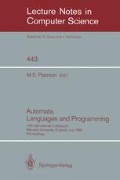extended abstract
Preview
Unable to display preview. Download preview PDF.
References
Binder, K., Monte Carlo investigations of phase transitions and critical phenomena, in Phase Transitions and Critical Phenomena, Volume 5b (C. Domb and M. S. Green eds.), Academic Press, London, 1976, pp. 1–105.
Cipra, B., An introduction to the Ising model, American Mathematical Monthly, 94 (1987), pp. 937–959.
Diaconis, P. and Stroock D., Geometric bounds for eigenvalues of Markov chains, Technical Report No. 325, Department of Statistics, Stanford University, July 1989.
Dyer, M., Frieze, A., and Kannan, R., A random polynomial time algorithm for approximating the volume of convex bodies, Proceedings of the 21st ACM Symposium on Theory of Computing, 1989, pp. 375–381.
Feller, W., An introduction to probability theory and its applications, Volume I (3rd edition), John Wiley, New York, 1968.
Fisher, M. E., On the dimer solution of planar Ising models, Journal of Mathematical Physics 7 (1966), pp. 1776–1781.
Ising, E., Beitrag zur Theorie des Ferromagnetismus, Zeitschrift für Physik 31 (1925), pp. 253–258.
Jerrum, M. R. and Sinclair, A. J., Approximating the permanent, SIAM Journal on Computing 18 (1989), pp. 1149–1178.
Jerrum, M. R. and Sinclair, A. J., Polynomial-time approximation algorithms for the Ising model, Internal Report CSR-1-90, Department of Computer Science, University of Edinburgh (submitted to Journal of the ACM).
Jerrum, M. R., Valiant, L. G., and Vazirani, V. V., Random generation of combinatorial structures from a uniform distribution, Theoretical Computer Science 43 (1986), pp. 169–188.
Karp, R. M. and Luby, M., Monte-Carlo algorithms for enumeration and reliability problems, Proceedings of the 24th IEEE Symposium on Foundations of Computer Science, 1983, pp. 56–64.
Kasteleyn, P. W., Dimer statistics and phase transitions, Journal of Mathematical Physics 4 (1963), pp. 287–293.
Kirkpatrick, S., Gelatt, C., and Vecchi, M., Optimisation by simulated annealing, Science 220 (May 1983), pp. 671–680.
Lenz, W., Beitrag zum Verständnis der magnetischen Erscheinungen in festen Körpern, Zeitschrift für Physik 21 (1920), pp. 613–615.
Newell, G. F. and Montroll, E. W., On the theory of the Ising model of ferromagnetism, Reviews of Modern Physics 25 (1953), pp. 353–389.
Sinclair, A., Randomised Algorithms for Counting and Generating Combinatorial Structures, Ph.D. Thesis, University of Edinburgh, 1988.
Sinclair, A. and Jerrum, M., Approximate counting, uniform generation, and rapidly mixing Markov chains, Information and Computation 82 (1989), pp. 93–133.
Welsh, D. J. A., The computational complexity of some classical problems from statistical physics, in Disorder in Physical Systems, Oxford University Press, February 1990, pp. 307–321.
Author information
Authors and Affiliations
Editor information
Rights and permissions
Copyright information
© 1990 Springer-Verlag Berlin Heidelberg
About this paper
Cite this paper
Jerrum, M., Sinclair, A. (1990). Polynomial-time approximation algorithms for the ising model. In: Paterson, M.S. (eds) Automata, Languages and Programming. ICALP 1990. Lecture Notes in Computer Science, vol 443. Springer, Berlin, Heidelberg. https://doi.org/10.1007/BFb0032051
Download citation
DOI: https://doi.org/10.1007/BFb0032051
Published:
Publisher Name: Springer, Berlin, Heidelberg
Print ISBN: 978-3-540-52826-5
Online ISBN: 978-3-540-47159-2
eBook Packages: Springer Book Archive

